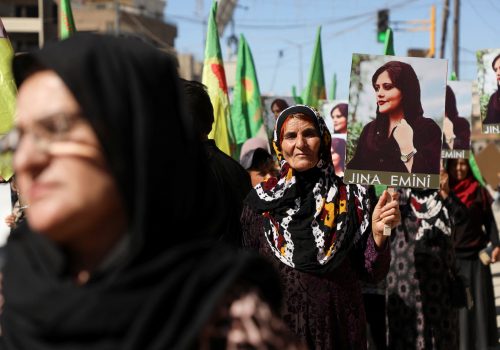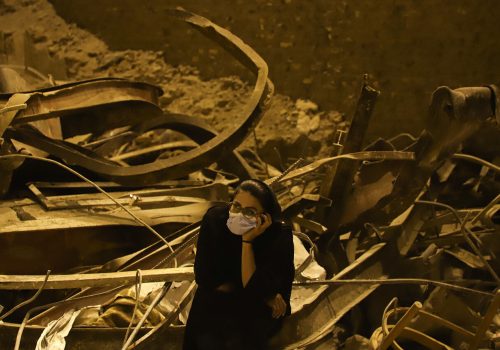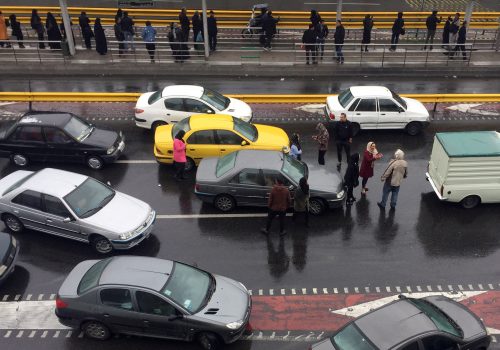How to turn Iran’s moment into a movement
They have been pouring into the streets for nearly two weeks and are determined to bring about fundamental change. But when asked about the plans and emerging leadership of the nationwide movement that has sprung up in the wake of the killing of Mahsa Amina by “morality police,” one protester shrugged in exasperation.
“These are kids, most of them,” said the thirty-something Tehran resident who has taken part in some of the protests, and even boasted he had helped torch a police vehicle. “Most are sixteen to twenty years old.”
The protests, which began on September 16, are some of the biggest and most widespread since the 2019 protests over the hiking of food and fuel prices. In many ways, they are more demographically diverse than the 2009 protests that followed the disputed re-election of Mahmoud Ahmadinejad or the student-led uprisings that followed the shutdowns of reformist newspapers in 1999.
The often very young protesters who make up the front lines of the mostly amorphous movement, which was sparked by the still-unexplained death of the twenty-two-year-old Kurdish woman, are acting out of passion rather than political calculations. That is what motivates them to confront security forces and turn out night after night on the streets regardless of whether video of the protests makes it to the outside world due to Internet throttling and near-total shutdowns.
“The situation in the city has not changed,” said an Iranian women’s rights activist protesting against the regime in Tehran on September 25. “Streets were crowded, very crowded, with a lot of people.”
But zeal alone can rarely power political change, especially against a determined and consistently violent regime like the Islamic Republic. Just look at the way mass spontaneous protests in Iraq and Lebanon in 2019 failed to dislodge entrenched elites. A sustained political movement requires discipline, leadership, and perhaps even hierarchy—if not a chain of command, at least a designation of duties. Building a movement will require time and resources. But the recent uprising has perhaps more clearly delineated some of the major challenges ahead.
On social media and in online chat rooms that draw Iranians from inside and outside the country, there are intense and valuable debates about how to translate righteous rage into a bona fide political movement that brings about some measure of political change, or even the downfall of the Islamic Republic. They speak of seizing and holding control of neighborhoods and towns and organizing community efforts to gather food and supplies, bolster security, provide first aid to the injured, and procure funds to support those jailed in the protests.
Building a mechanism to support such detainees is a key and oft-neglected issue, and a more effective way for Iranians abroad to contribute than clashing with cops in London or Milan. Washington can ease financial restrictions to allow international financial support for prisoners and their lawyers, who are also being arrested. Over the last eleven days, many activists have been living on the run, sleeping in different homes in fear of regime enforcers breaking down their door.
“They are arresting everyone right now–especially photographers, journalists, documentarists,” said an Iranian women’s rights activist, who wished to remain anonymous for fear of reprisal. “They are storming people’s houses and making a lot of noise while they do it. That’s how they provoke fear and terror. How much can people handle?”
On social media, the hashtag “nationwide strikes” was trending this week, and there were calls for getting shopkeepers and private businesses to close up following announcements of stoppages by some university students and educators. At best, so far, the results in Iranian cities were ambiguous, and there appeared to be few if any moves by workers in key industries, such as oil and petrochemicals, to take labor action. But that could change, and at least the discussion is focused on the right topic.
In addition to the Basiji militias and the black-clad riot police, the regime has many non-violent tools of repression at its disposal. Cutting off the Internet shrouds events in Iran from the outside world, but perhaps more importantly, it blocks communications within Iran, preventing those in the capital’s Haft-e-Tir Square from coordinating with those up in Tajrish, or Baluchi activists in the southeast from connecting with their Kurdish compatriots in the country’s northwest.
The Iranian women’s rights activist said she spent much of her days now switching between around fifteen virtual private networks (VPNs) to access news websites and information.
“The internet is so bad it has already reached the edge of nothing,” she said. “Sending even short videos is close to impossible—it could take hours.”
Business magnate Elon Musk has already announced that his firm has turned on the Starlink satellite internet network over Iran; now supporters of the protest movement must smuggle thousands of units into the country. Each unit costs $600 and monthly subscriptions of $110, fees that can be waived or picked up by friends of the Iranian opposition abroad.
But maybe it would be valuable for Iranians to develop other means of communication. Already, protesters too frightened to march through the streets shout slogans from their rooftops or patrol the streets in their cars to provide cover for protesters and slow down regime attack squads on motorcycles and in vans. Perhaps such individuals could be tasked with communicating messages and information across cities or neighborhoods.
Some Iranians famously and perhaps tragically adhere to a kind of regional exceptionalism where they believe that they are immune to the rhythms and dynamics of the broader Middle East. But demonstrators would do well to heed lessons from recent revolts against autocracy in the Arab world. Uprisings in Egypt and Tunisia in 2011 and Algeria in 2019 ousted leaders when the military turned against the longtime ruler. Uprisings against longtime autocrats in Libya in 2011 and Sudan in 2019 succeeded after protesters’ political allies visited foreign capitals and convinced regional powers that the opposition could responsibly lead their nations.
As the outcomes of all those Middle East uprisings have shown, there is a long road between the ousting of a regime and the democratic, inclusive outcome they aspire to. Many dangers stand in the way and things can always get far worse than before, as they have in Syria and Yemen. Iranians would do well to realize that they are playing a long game, and that unseating or transforming a dictatorship as entrenched as the Islamic Republic is a chess match far more than a bout of arm wrestling.
In Iran, the momentum is there. It just needs direction and a helping hand.
“I think the protests will continue,” said the women’s rights activist. “People will continue to come into the streets. It’s not important for them if they live or die or get arrested. And it shouldn’t be important. I have gone every day. I think everyone should go. Because, if we retreat, they will get rid of all of us.”
Borzou Daragahi is an international correspondent for The Independent. He has covered the Middle East and North Africa since 2002. He is also a Nonresident Fellow with the Atlantic Council’s Middle East Security Initiative. Follow him on Twitter: @borzou.
Further reading
Mon, Sep 26, 2022
‘Women, life, liberty’: Iran’s future is female
IranSource By
Women, young and old, have been at the forefront of the uprising, just like every other protest in Iran over the past decades.
Wed, Jun 8, 2022
‘From Cinema Rex to Metropol,’ Iranians have had enough
IranSource By
On May 23, a ten-story commercial tower came crashing down on people’s heads in Abadan. With each body recovered from the ruins, public anger crescendoed, leading to ongoing street protests in multiple areas in Khuzestan province and beyond.
Wed, Mar 24, 2021
#No2IslamicRepublic: Just a hashtag or much more?
IranSource By
On March 11, an anti-government campaign was launched with the hashtag #No2IslamicRepublic in English and Persian. The movement was announced via a statement signed by 640 Iranians, including those inside and outside Iran.
Image: An Iranian woman takes part in a demonstration against the political regime in Iran in front of the US consulate in Frankfurt. She holds a poster with the picture of 22-year-old Mahsa Amini, who died last week in Iran after being arrested by the morality police.


